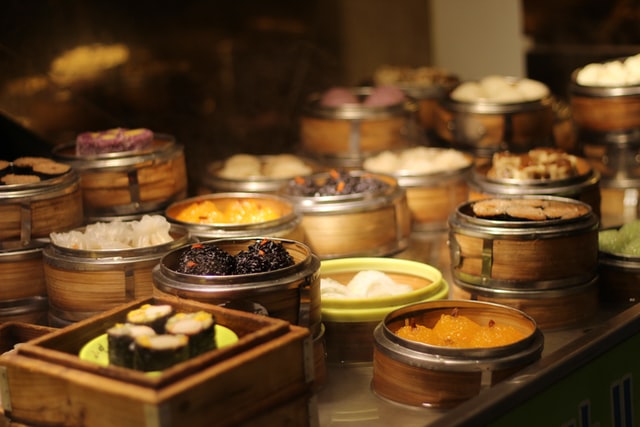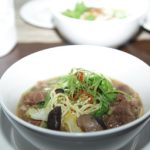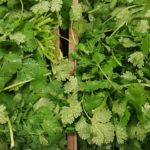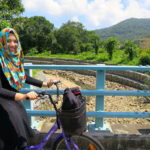Learning Yin from Yang While Dining in Shanghai

I sat slumped against the window just six hours into the 16-hour flight from Newark to Shanghai. My three friends slept beside me, in transit to visit my roommate Ruting’s hometown. The guidebook on China sitting in my lap recommended the best festivals or special attractions in the country month-by-month. These ranged from Buddha’s Birthday to the Great Wall Marathon to Chinese New Year. The recommendations thin out in the fall and early winter months, however. From October through December the only attraction listed was Hairy crabs in Shanghai. We were arriving at the perfect time to enjoy the Shanghai delicacy! I was intrigued.
After arriving in Shanghai we sped past tall buildings adorned with flashing neon signs. “Wow, it looks like Vegas!” we exclaimed. “Chinese Vegas!” “Crab Vegas!”
Flashing crabs waved their claws at us in welcome. Ruting, effortlessly switching between Mandarin and English, informed us that some signed kept it simple and advertised “crabs,” while others took it further with “BEST crabs”, enticing crab puns, and promises of Shanghai hairy crabs.
Qi is “the original air” that fills our bodies. It rotates through the canals of our bones and, when cycling properly, this circling life force grants us energy and comfort.
While Crab Vegas was indeed captivating, we sped on, headed for somewhere better. Ruting’s mom was friends with some interesting people: the owner of the French bakery down the block, the owner of the Korean barbeque one metro stop north, and, perhaps best of all, a family of crab farmers 40 minutes from downtown Shanghai who welcomed us into their home and transformed it into an intimate, one-table restaurant.
Little dishes of brown sauce were dotted around the table. Finely minced ginger chunks floated in a bath of vinegar, providing some warmth to accompany the cold crab. The Chinese description of warmth and coolness in food reflects the principles of yin and yang, a fine balance taken seriously in China. Cold foods include soy products like tofu, crab, fish, and most fruits, while warm foods include beef, ginger, and fried foods.
There are no strict guidelines on whether a food is cold (yin) or warm (yang), but it’s an intuitive classification, learned experimentally. People believe that eating too many cold foods risks an encounter with diarrhea, while a warm imbalance expresses itself as cold sores and stomach irritation.
Ruting’s mother explained to us further: These different foods manipulate the balance of the body, but it begins before that even, with qi. Qi is “the original air” that fills our bodies. It rotates through the canals of our bones and, when cycling properly, this circling life force grants us energy and comfort. However, the qi can get stuck in the crevices through which it travels. When this happens, balance is overthrown, resulting in pain and discomfort.
The Chinese description of warmth and coolness in food reflects the principles of yin and yang, a fine balance taken seriously in China.
A plate piled high with steaming crabs was brought to the table. The crabs were small, their bodies no larger than the palm of the hand, with spindly legs thinner than my fingers. The crabs were from a freshwater lake, but being from landlocked Colorado, the fishy smell visibly swirling from their hot shells reminded me of the ocean. From behind, the crabs looked like those served in Maryland (sans Old Bay seasoning), but from the front it appeared as if each crab had been smeared with a sticky gray mud. This was their hair; stubble befitting a hairy crab covered their thin legs.
I followed the others’ lead and pulled the shell away from the abdomen, plucking out the undesirable spongy lungs. The plush white meat was coated with bright golden roe. Roe is to crab as caviar is to fish, and it’s prized for its rich flavor. They’re eggs, and makes female crabs more valuable than males.
Learning Yin from Yang While Dining in Shanghai.
I was managing a yin-yang balance of my own at the dinner table. Back in the US I had been predominantly vegetarian, but in China I didn’t want to miss out on anything. Traveling is a time to explore, even if it meant cheating on my diet. I scooped up a small amount of the vibrant roe with my chopstick and brought it to my tongue. The small, creamy portion spread around my mouth, as flavorful as I imagined an entire little leg to be. I cracked a leg at its joint and dipped it into the warm sauce, brought the hollow opening to my lips. I sucked, harder than I thought I’d have to, and a cylinder of meat half the width of a pencil flew into my mouth. The crab was sweet and juicy, and I quickly cracked another leg.
Photo for Learning Yin from Yang While Dining in Shanghai by Unsplash.








